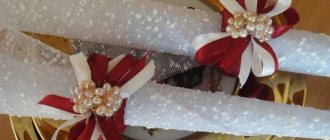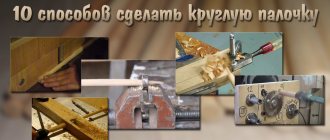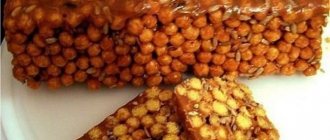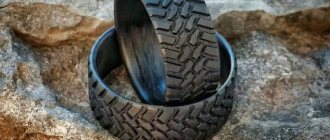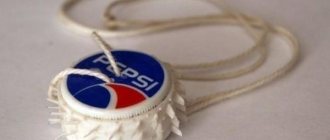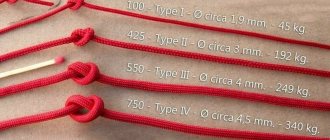From plastic pipes
You can make not exactly rings, but projectiles with which you can completely practice, just like with rings.
Take two cables, two carabiners (at least 100 kilograms each), a piece of pipe 5 centimeters in diameter and 10 centimeters long (two pieces, wrap with electrical tape to prevent your hands from slipping), two chains 30 centimeters long.
The cables need to be thrown over a tree branch so that there is a distance of about half a meter between them. Wrap the cable three times so that it does not wobble; the ends should hang 40 centimeters above your raised arms. We attach carabiners to the ends of the cables, and to them we attach a chain passed through plastic tubes. These rings are quite easy to make and you can do the same exercises with them as with professional equipment.
Just pay special attention to the strength of the structure; it must be injury-proof.
Made of wood
Wooden gymnastic rings, when manufactured correctly, will be no worse than professional ones, if you approach the technology correctly. Since the rings experience heavy loads during exercise, a regular board will not work, as it will quickly split into fibers, and it’s good if there is no injury.
The projectile requires plywood. Since gymnastic rings must have an internal diameter of 180 millimeters, and the diameter of the handle must be 30 millimeters, the plywood sheet must be selected accordingly. You won’t find plywood of such thickness, so you need to cut squares with a side of 270 millimeters and glue them together so that the final thickness of the workpiece exceeds 30 millimeters.
You need to take either a special carpenter's glue or a universal one, but not a glue glue, but one with a long drying period, for example Moment, then the workpieces will stick together firmly and for a long time. The glued plywood sheets must be kept under pressure; you can place a weight or any other suitable size object. You can even place it under the foot of a bed or cabinet, if possible (after placing a gasket so as not to damage the surface).
On the glued sheet we use compasses to mark the circles along which we will cut the rings - the internal diameter should be 180 millimeters, and the external one should not be 30 millimeters, but be equal to the thickness of the glued sheet, so that the cut circle is square in cross-section.
Using a drill, we drill holes for the jigsaw and cut along the marked circle. Next, we secure the workpiece in a vice, take a rasp and smooth out the corners, thus forming regular rings. Then we work with sandpaper and polish with fine sandpaper. Take a closer look to make sure there are no rolling pins or irregularities, since what is not very noticeable to the eye will be felt by your hands. These rings are strong and light.
Wall for little ones
If there is only enough space in the apartment for a children's sports corner, it can be attached to the load-bearing wall at only 2 points.
Scheme of a children's wall for preschoolers and primary schoolchildren:
To decorate the bowstrings, a construction board without defects and knots or plywood 20 mm thick is suitable.
Crossbars can be made from scraps of garden tool holders.
The crossbar of the horizontal bar is fixed in its holder with self-tapping screws (6 mm) from the front end of each of the brackets.
The equipment for such a sports corner is fastened to the wall using card loops.
To install a removable horizontal bar holder, the grooves of the brackets are placed on the crossbars of the wall bars. Next, turn the holder itself upward. And the grips of the stretch marks lead to the next crossbar (up). Then they pull the horizontal bar down onto the crossbar. And then it will hang “tightly”, no matter what the child does on it.
The algorithm for subsequent actions is as follows:
It should be very strong - you won’t be able to tear it off!
Children's gymnastic rings
Many parents are interested in what age a child can play sports equipment, and how beneficial it is for healthy physical development. Since training on rings is a type of strength training and is quite similar to the use of parallel bars and a horizontal bar, children can be introduced to them from a very early age.
The advantage of rings for children is as follows:
- Unlike the same horizontal bars, the projectile is unstable. Accordingly, physical development occurs faster.
- Ring training is particularly varied, which prevents children from getting bored. This point becomes extremely important in cases where it is necessary to interest the baby in monotonous training.
Additional inventory
Training requires special gloves that ensure a secure hold of the rings and prevent injury to the skin of the hands due to friction. Gloves are not required if the apparatus is used for the purpose of general physical development, including the development of muscles and flexibility. A soft mat with a significant area is also required. It spreads under the apparatus and is necessary to prevent the gymnast from getting injured when falling. In addition, the mat reduces the stress on the joints during a dismount.
DIY gymnastic rings
For home training, it is absolutely not necessary to purchase ready-made, expensive equipment. If you have a strong desire, tools and materials, you can make quite effective rings with your own hands.
The main thing when assembling a projectile is not so much a strong suspension as the presence of a reliable mount on which the structure will be placed. Alternatively, you can hang the rings on a thick tree branch, securing them to a good rope. It is desirable that such a crossbar be straight, parallel to the ground and support the weight of each family member who plans to use the device.
Self-assembly of gymnastic rings involves performing work in several successive stages:
- The ropes are thrown over the branch and wrapped around several times. The hangers should be placed at a distance of approximately 50 cm from each other.
- Carabiners are attached to the ends, which must be designed for a certain weight with some margin.
- Wooden or plastic rings are wrapped with fabric tape, which reduces the sliding effect.
- The rings are connected to the carabiners using chains.
Unfortunately, not each of us has the opportunity to buy ready-made gymnastic rings. Therefore, assembling them at home from scrap materials looks like an excellent option for organizing regular strength training.
Wood or plastic
Initially, wooden gymnastic rings were used. However, due to the growing popularity of fitness classes, lightweight plastic models have become widespread.
In fact, there are no defining differences between the specified materials of manufacture. However, there are still some features that deserve attention.
The sensations that the athlete experiences during training come first. The surface of the plastic is rough, which increases grip when in contact with the hands. In contrast, wooden products contain a smooth varnish finish. Both specifications are considered by individual athletes to be both advantages and disadvantages. It all depends on personal goals and needs.
If plastic rings have a perfect circle, then a wooden projectile has an oval shape. This difference affects the comfort of grip when performing certain exercises.
Fastening
A home sports corner for children can be mounted between the floor and the ceiling using a spacer, if the ceiling is made of concrete and the floor is made of durable laminate or other equally reliable coating on a self-leveling basis, without lags. Otherwise, there is a high risk of the complex collapsing and causing injuries to those involved.
Fastening the elements of the sports corner with anchor bolts is considered the most reliable. Although, if you know how, you can ensure the most reliable fastening of your home complex at just two points.
GYMNASTIC RINGS made of high quality wood
We present to your attention wooden gymnastic rings from. The rings are designed for strength training and development of movement coordination. This equipment can be used both for professional training and for sports at home
The latter is very important for children, for whom an early start to training is useful and productive.
This is why gymnastic rings are so popular and loved by both professional athletes and boys of any kind.
Briefly about the projectile Sports rings from are a projectile in the form of a pair of wooden rings that are attached to durable hangers. Our company makes rings exclusively from wood, not plastic. This allows us to say that they are durable, environmentally friendly, last a long time and have an attractive classic appearance. The rings are attached at the desired height using cables; the kit also has strong and reliable fastenings. The slings are made of reliable synthetic material, and the locks are made of steel. Therefore, for our gymnastic rings we allow super-heavy weights up to 250 kg.
What exercises are performed on rings? Exercises are usually performed on gymnastic rings, which are the same for both professional athletes and ordinary people who are concerned about maintaining health and good physical shape. So, on the rings they perform: • emphasis on the hands; • lifting; • rotation; • swing elements; • twisting.
Rings allow you to use both dynamic exercises and static exercises. Moreover, the former are less difficult than the latter, since static exercises give a greater load.
Equipment for everyone The above exercises are part of the mandatory exercises of the Olympic Games and Championships program. However, the value of the rings is not only that they are used for professional sports, but also that the rings can be used for sports activities and even games, including with children and teenagers. Because the earlier a child starts, the sooner he comes to gymnastics and gives better results. An early start is also good for yard activities not related to professional training. After all, this equipment allows you to train endurance, strength and the ability to maintain balance - gymnastic rings are characterized by the lack of stable points of support, and therefore an early start to training with rings will allow the child to learn to maintain balance and control his body.
The benefits of MONKO rings We recommend purchasing training rings from not only for organizing the training process in gyms. We also advise you to buy rings for outdoor activities and hang them at home. They are especially good if the family has a child of 3 years or more. As mentioned above, an early start in accessible and gentle strength sports is beneficial for the child’s body.
What is important is the ease of mounting. You can take your home rings with you if you go to the sports field. After working out for the right amount of time, they are easy to unhook and assemble, taking them home. You can do pull-ups, push-ups, or just hang with benefits for your muscles and spine on our durable and comfortable rings.
How to buy gymnastic rings? To purchase these useful rings, you don't have to go to the store and buy rings there. You can purchase high-quality and inexpensive sports equipment right at home. Simply select the type of sports equipment you need and make a request. And at the time you need, our courier will deliver the rings directly to your home.
What is important: the price of our rings is cheaper than, for example, Rogue gymnastic rings. At the same time, the quality of our rings is high.
Kinds
The following types of materials are used in the manufacture of structures: plastic, metal and wood. Moreover, wooden shells appeared long before plastic was invented. Let's look at each option in more detail and determine the positive and negative characteristics of each product.
Wooden
They appeared very first and were very popular among athletes.
| Advantages | Flaws |
| It has excellent grip for a direct grip, as the material is able to absorb moisture released by the palms. | Being constantly outdoors, they quickly become unusable. |
| Once polished, it feels great in your hands. | Short service life. |
| Aesthetic. | The average price is quite significant. |
| They are thicker than their analogues. |
Plastic
Not any material is suitable for manufacturing, but a special one - ABS.
| pros | Minuses |
| Inexpensive. | The grip on the palms is poor, especially when the hands are sweaty. |
| Their service life is quite long. | They can slip, so you should pre-treat your palms with chalk. |
| Shockproof. | It is difficult to maintain a reverse grip for a long time. |
| Long-term training may cause damage to your hands. |
Metal
It is considered a fairly strong and wear-resistant equipment. The upper part is a rubber coating applied in a thick layer. This helps to avoid slipping and get rid of the feeling of cold that comes from any metal products.
| Positive qualities | Negative qualities |
| Durability. | Heavy weight. |
| Used by athletes whose weight exceeds 100 kg. | They don't come on a budget. |
The kit also includes a cable. The more elastic it is, the less stress is placed on the muscles during dynamic exercises. In professional sports, steel cables with zero elasticity are used. Amateur options are usually hung on thick cords.
What are the diameters of rings? There are certain standards. Thus, exercise equipment for adults can be 28 mm, 30 mm and 32 mm thick. It all depends on the person’s build. It is worth noting that it is mainly men who train on such equipment and reach significant heights, whose weight is about 55 kg and height is approximately 165 cm. But not all men are “compact”. The larger the person, the thicker the weapon he will need.
A separate category includes exercise equipment for children. Their internal diameter is significantly smaller than in the adult version. If you want to devote yourself to this particular sport, then you need to start practicing from early childhood. This helps develop endurance, increase strength, mobility, and turn training into an amazing game that will bring pleasure to the child.
What abilities do ring exercises develop?
Training using sports equipment improves coordination, strength, agility and flexibility. Regular exercises make it possible to feel full control over your own body and get a good basis for playing various sports.
Gymnastic rings belong to the category of universal devices. They not only effectively replace the horizontal bar, but also provide superiority in certain indicators.
The advantage of the projectile is the effect of instability, which is created by the suspension system, which allows you to obtain additional power load when performing exercises. Since gymnastics rings move in all directions, the muscles have to work more actively.
Periodic exercises using sports equipment contribute to the active building of muscle mass in the upper limbs and the entire shoulder girdle. You can use gymnastic rings to develop your abdominal muscles when lifting your legs.
What are gymnastic rings for?
Good muscle definition and overall separation are the result of long and proper training on the rings. Despite their relatively small muscle volumes in comparison with the same bodybuilders, gymnast athletes have more pronounced muscles. This is a kind of phenomenon, because training with rings uses only your own body weight as weight.
Each muscle cell can increase its strength and speed-contractile characteristics several times without increasing in size. At the same time, it will undergo some modifications. Nowadays, the result of this process is called stiffness or density of muscle myofibers.
When training with classical weights, muscle cells divide without changing the number of myofibrils, and therefore many famous bodybuilders have massive, but not fibrous biceps. In athletes, on the contrary, the fiber is clearly visible even to the naked eye - the muscles always look trained, stiff and with separate separation. Athletes who regularly exercise with gymnastic rings can boast of well-developed muscles, although not as large as those of bodybuilders.
What should gymnastic rings be like?
Regardless of the modification, gymnastic rings have an equal diameter - 18 cm, and the distance between them in a free state is 50 cm. These standards are determined by the rules of the Gymnastics Federation. Included with the rings are a pair of strong slings 4 meters long, each equipped with a strong spring or other lock.
What is the difference between professional and amateur rings?
The most important thing in a set of rings is the suspension system; the cost of it is much higher than the rings themselves. It is in the suspension system that the difference between an amateur projectile and a professional one is hidden.
Amateur rings are equipped with straps with a spring lock that is easy to open and close, meaning they can be hung anywhere you want to exercise and then removed. The professional suspension system is more complex and is aimed more at stationary use.
This classification is strictly observed only in varieties of gymnastics; if we are talking about sports such as CrossFit, then they use amateur suspensions. Even the CrossFit World Championships are held with simplified rings, that is, with those that have regular spring locks on the lines. Based on this, you can safely make a choice in favor of amateur rings, especially when it comes to independent training. In this case, it is not at all necessary to overpay for a professional fastening system.
Plastic and wooden rings
The very first gymnastic rings were made exclusively of wood, and these are still present in the sports industry to this day. Due to the popularity of workout and crossfit, they also began to produce plastic rings. It cannot be said that the two varieties are radically different from each other, but there are still certain differences that must be taken into account when choosing a projectile.
The main difference is the type of surface; the wooden rings are completely smooth and varnished. The plastic rings have some roughness that can be felt in use; slight irregularities increase the grip between the hand and the ring. Smoothness cannot be attributed to the clear pros or cons of the product; each athlete selects rings to his own taste.
Another noticeable difference is the shape. The specifics of the production process make the wooden rings not round, but rather slightly elongated. The plastic rings are a perfect circle. This criterion is also not very important in its use; it is rather a matter of habit.
Rings for home use
Amateur rings with spring locks on the fastenings can be used both in open spaces and at home, for example, in bad weather. You can train at home on rings if you meet the main condition - having a place to hang them and a sufficient amount of free space around. You can install a horizontal bar in any apartment, but the rings require strong and high ceilings. Not every home is suitable according to this principle, so that it is convenient to train on the rings. If you have the opportunity to place rings, then do it as quickly as possible, then you can train at any convenient time!
Children's gymnastic rings
If parents are fond of sports and encourage an active lifestyle, sooner or later they will ask the question, at what age can children do ring training? This question is brought up by offers to purchase children's gymnastic rings, these are offered in many stores; they are similar to standard plastic rings, only of a smaller diameter.
All exercises performed on rings are bodyweight training. Such exercises can be performed from a very early age, only before moving on to the rings, you need to master the exercises on the crossbar. The rings are much more interesting than the crossbar; they do not have a strictly fixed position, so learning how to handle them is much more difficult. Children are attracted by the prospect of learning how to do exercises on rings, and this is the main advantage of the apparatus; a stable crossbar gets boring over time.
As for children's rings, this is not a sports equipment, but rather a toy, so their quality leaves much to be desired. In sports gymnastics sections for children, standard rings are immediately used, so universal rings will be the best purchase for home training. You can buy gymnastic rings both at specialized sports outlets and in online stores.
The evolution of ring gymnastics
The rings gymnastics program includes two parts: strength and swing. In different years, one of them, then the other, prevailed. In this discipline, development proceeds in a spiral manner.
1930-50s
In ring gymnastics of the 30s, the strength part had the advantage; its elements were very complex. The flywheel is characterized by the presence of only twists forward or backward, and the amplitude does not develop. A simple dismount ends the performance. It represents a back somersault, bending over.
The elements of the power unit had to be held for at least three seconds. This fragment of the performance is characterized by the presence of angles, handstands, different revolutions, crosses, etc. In 1936, such a complex element as the “cross” was performed by all athletes without exception, and its execution was of different types. In addition, in those years one could see the implementation of the “reverse cross”, which would gain popularity only 50 years later. Also in the 30s, attempts were made to create an “airplane”.
In the late 50s, almost nothing had changed. Strength exercises still prevailed, but in the fly part attempts began to perform large rotations through bent arms.
The outstanding gymnast of that time was the Soviet athlete Albert Azaryan, three-time Olympic champion, four-time world champion. His program is a model for all athletes in this discipline of the late 50s. He was the first to perform the element “forcibly from the hang, flip back into the cross,” which is still listed in the international regulations under the name “Azaryan.”
1960s
At this time, significant changes occurred in ring gymnastics. The revolution in combinations took place thanks to the talented athlete Mikhail Voronin. He pioneered the use of a new technique for performing large rotations, which made it possible to perform them in such a way that the arms remained straight. The capabilities of the flywheel component have been rethought. In the mid-60s, they stopped performing such power cascades as in the 50s. The attention of athletes turned to high twists and high revolutions. Dismounts have become more difficult.
1970s
The combinations of these years have not undergone major changes. Flying elements developed. In 1976, the Japanese athlete Fukio Honma demonstrated a new product - a forward flip lift, which began to be included in the combinations of all leading gymnasts. Athletes of the 70s carefully practiced dismounts, improving them. At the end of the decade, gymnasts performed the dismount in the form of a double back somersault while bending over.
The development also affected the power part, although each combination consisted of no more than two complex static stops.
1980s
At the beginning of the decade, flywheel elements continued to develop. For example, Yuri Korolev performed a triple backflip into a dismount. This trick had already been demonstrated in the 70s, but then it seemed strange and impossible to perform in the future. Now the triple somersault is performed by many athletes.
An interesting experiment was carried out by Chinese gymnast Li Ning. He transferred elements performed on the crossbar to ring gymnastics. In 1983, each athletes’ program was characterized by the presence of two power elements: a cross and a horizontal support “legs together”. The end of the 80s was marked by an innovation in the flywheel - double forward rotations in a tuck or bent position. Statics has become more complex. The “Azaryan Cross” was very popular.
1990s
For twenty years there was almost no evolution in programs. The development of gymnastics proceeded slowly, small complications were added gradually. In the 90s, serious changes took place. In 1992, the rules changed; athletes were required to predominate in the complex static part. The swing program was again transformed into a strength program.
At the Olympic Games in 1996, gymnasts no longer performed two, but four elements of the power section. The degree of their complexity has also increased. For example, an element such as “airplane” was improved by the Italian athlete Yuri Keki. He performed it flawlessly - all parts of the body formed one straight line.
The swing section of the program at this time was represented only by large revolutions. The dismount was simplified - it was performed in the form of a regular double blanche backwards.
2000-2010
During this period the rules changed again. There are additional points for connecting power elements. Athletes formed their combinations in different ways. The programs contained four or five power elements performed one after another. For example, “Kip-up into an airplane”, “Horizontal hang from behind into a cross”, “Rise into an airplane” and “Azaryan cross”. Other gymnasts combined swing and power lifts in static elements.
2005 – the peak of development of complex combinations of power section elements.
In 2006, the rules changed dramatically. There was no base, but a score for complexity appeared. It increased as the program was filled with the maximum number of difficulties. The combination had to contain ten difficult elements. Requirements for the dismount are not lower than group D. An increase for connecting strength exercises was given if the athlete increased the center of gravity in the next element relative to the previous one. In 2009, the rules were changed again. Increases for connections of power section elements have been removed.
In 2009-2010 the difference in the complexity of the combination between the “siloviki” and the “flywheels” has almost disappeared. These years saw high competition between gymnasts. The technique of performing strength exercises was very high. An example of a combination of these years is the program of the Chinese athlete Yang Mingyong. Its power part consisted of seven complex elements.
2011 – 2022
The results of the 2012 Olympics showed that the complexity of the programs of the world's leading gymnasts was already 6.8-6.9, and its subsequent increase is fraught with problems in the quality of performance. In this regard, athletes began to work more on the purity of performing strength exercises. By 2015, most gymnasts had perfected their dismounts.
